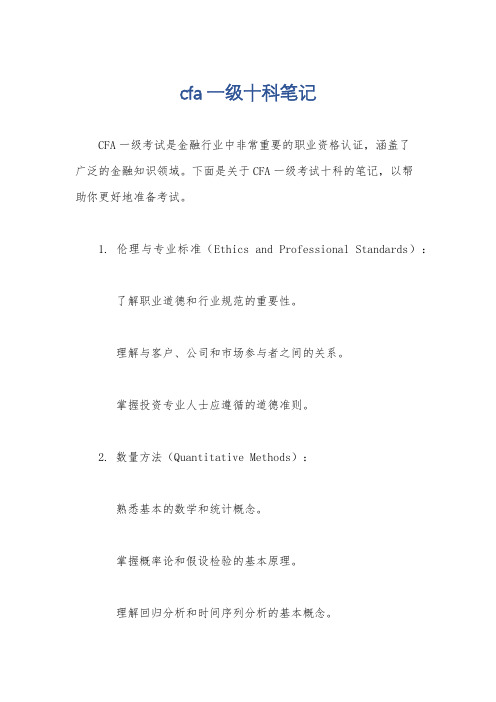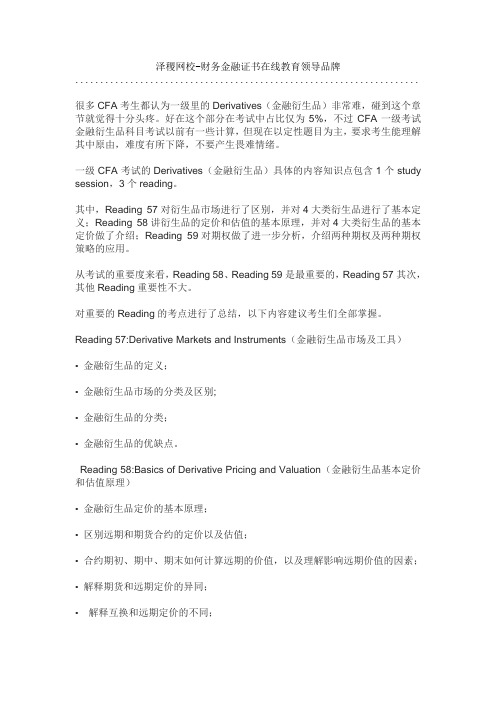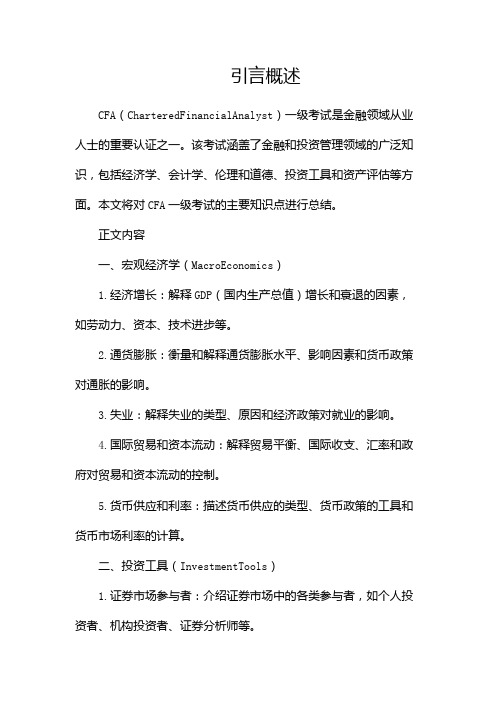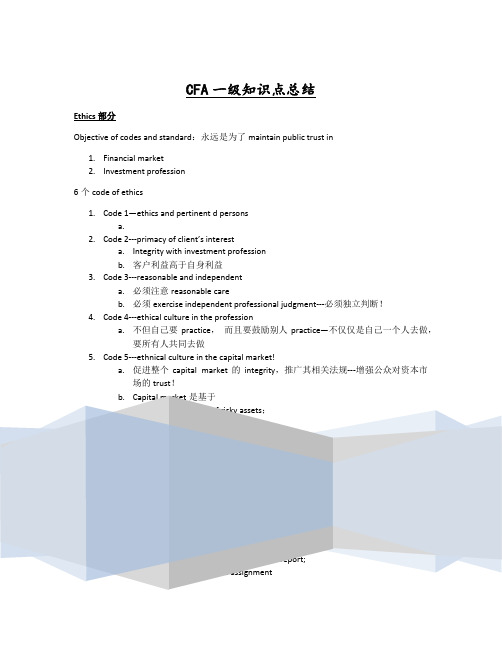泽稷教育 CFA一级固定收益Notching知识点详解
cfa一级十科笔记

cfa一级十科笔记CFA一级考试是金融行业中非常重要的职业资格认证,涵盖了广泛的金融知识领域。
下面是关于CFA一级考试十科的笔记,以帮助你更好地准备考试。
1. 伦理与专业标准(Ethics and Professional Standards):了解职业道德和行业规范的重要性。
理解与客户、公司和市场参与者之间的关系。
掌握投资专业人士应遵循的道德准则。
2. 数量方法(Quantitative Methods):熟悉基本的数学和统计概念。
掌握概率论和假设检验的基本原理。
理解回归分析和时间序列分析的基本概念。
3. 经济学(Economics):理解宏观经济和微观经济的基本原理。
掌握货币政策、财政政策和国际贸易的影响。
理解经济指标和金融市场之间的关系。
4. 金融报表分析(Financial Reporting and Analysis):理解财务报表的结构和内容。
掌握财务比率分析和财务报表的解读。
熟悉资产负债表、利润表和现金流量表之间的关系。
5. 公司金融(Corporate Finance):理解资本预算和资本结构的基本原理。
掌握投资决策和融资决策的方法。
熟悉公司治理和股权结构的影响。
6. 证券投资(Equity Investments):理解股票市场和股票投资的基本原理。
掌握股票估值和投资组合管理的方法。
熟悉股票投资的风险管理和绩效评估。
7. 固定收益投资(Fixed Income Investments):理解债券市场和债券投资的基本原理。
掌握债券估值和债券组合管理的方法。
熟悉利率风险和信用风险的评估和管理。
8. 衍生品投资(Derivative Investments):理解衍生品市场和衍生品投资的基本原理。
掌握期权、期货和其他衍生品的估值和交易策略。
熟悉衍生品投资的风险管理和绩效评估。
9. 另类投资(Alternative Investments):理解另类投资市场和另类投资的基本原理。
掌握房地产、私募股权和大宗商品等另类投资的特点和风险。
泽稷网校CFA一级财务报表的考查重点

泽稷网校-财务金融证书在线教育领导品牌..............................................财务报表分析是CFA考试的重头戏,在CFA一级考试中占比为20%,是所有课程中权重最高的一门课,所以说,这部分的内容必须引起我们的高度重视,才能把最关键的得分握在手中。
财报在整个CFA课程的知识体系下有着非常重要的作用,是许多课程基础和衍生。
一级财报的考查重点主要是对于基础财务报表和会计原理的理解,考得不深但是考查面非常广,要求考生对于不同的会计知识点能做到清楚的辨析和理解。
CFA一级考试中财务报表分析共有4个Session,Session7是导论,Session8是对于三张报表的解读,session9是对于一些复杂会计科目的介绍,Session10是财报质量和应用。
而这四个Session中包含了以下13个Reading。
从考试的重要度来看,Session8&9(其中包含了Reading25-32)是最重要的,占了绝大部分权重。
以下则是Reading25-Reading32中重要考点的总结,建议考生们全部掌握:Reading25:UnderstandingIncomeStatements(理解利润表)•辨析single-step和multiple-step格式的利润表;•辨析Unusualorinfrequentitems,Extraordinaryitems以及Discontinuedoperations;•计算长期合同的收入,费用以及利润。
•辨析gross以及netrevenue确认原则。
•计算BasicEPS及DilutiveEPS。
•记忆其他类综合收益(OCI)的构成,并会计算综合收益。
Reading26:UnderstandingBalanceSheets(理解资产负债表)•ClassifiedB/S的报告格式,记忆具体科目名称和含义;•辨析不同类别的measurementbase对于B/S的影响;•不同类别的金融资产如何被计入B/S,以及其损益如何影响I/S。
泽稷网校CFA一级金融衍生品的考查重点

泽稷网校-财务金融证书在线教育领导品牌.....................................................................很多CFA考生都认为一级里的Derivatives(金融衍生品)非常难,碰到这个章节就觉得十分头疼。
好在这个部分在考试中占比仅为5%,不过CFA一级考试金融衍生品科目考试以前有一些计算,但现在以定性题目为主,要求考生能理解其中原由,难度有所下降,不要产生畏难情绪。
一级CFA考试的Derivatives(金融衍生品)具体的内容知识点包含1个study session,3个reading。
其中,Reading 57对衍生品市场进行了区别,并对4大类衍生品进行了基本定义;Reading 58讲衍生品的定价和估值的基本原理,并对4大类衍生品的基本定价做了介绍;Reading 59对期权做了进一步分析,介绍两种期权及两种期权策略的应用。
从考试的重要度来看,Reading 58、Reading 59是最重要的,Reading 57其次,其他Reading重要性不大。
对重要的Reading的考点进行了总结,以下内容建议考生们全部掌握。
Reading 57:Derivative Markets and Instruments(金融衍生品市场及工具)• 金融衍生品的定义;• 金融衍生品市场的分类及区别;• 金融衍生品的分类;• 金融衍生品的优缺点。
Reading 58:Basics of Derivative Pricing and Valuation(金融衍生品基本定价和估值原理)• 金融衍生品定价的基本原理;• 区别远期和期货合约的定价以及估值;• 合约期初、期中、期末如何计算远期的价值,以及理解影响远期价值的因素;• 解释期货和远期定价的异同;• 解释互换和远期定价的不同;• 欧式期权价值的计算以及影响因素;• 欧式期权的平价公式、远期平价公式以及二叉树模型的理解;• 美式期权与欧式期权定价的差异。
泽稷网校 CFA一级考前必看

CFA一级考前必看距离2016年的CFA考试就剩最后的几天啦,相信大家正在抓紧最后的时间复习冲刺,那么,在这最后的时间里大家应该做些什么呢?01、CFA一级考点汇总CFA一级考试课程着重于投资评估和管理的工具和因素,包括资产评估和投资组合管理技巧的入门介绍。
第一阶段(LevelⅠ)形式为选择题(MultipleChoice),每卷各120题,共240题;职业伦理:提高从业人员的职业和道德素养,特别是国际上对受托人的责任的要求,降低了公司内部人员职业违规方面的风险,同时提升公司内部的整体职业素养,由此提高公司整体的管治。
数量分析:定量分析就是以数量工具测算投资组合关联性,概率统计,为设定合理理性的投资规划提供技术支撑。
在一级二级考试中是考试占比比较大的考试科目,考察金融分析中的一些常用的计算方法。
经济学:经济学课程以经典宏观、微观经济学内容讲解弹性、价格曲线、生产者剩余、消费者剩余、垄断和市场形态,宏观金融政策和中央银行等知识,让考生了解经济运行的宏观和微观经济知识。
财务报表分析:财务报表是CFA一级二级的考试重点,内容涉及三大会计报表,现金流量测控,养老会计、管理会计、税收规避FACC等会计术语,考试难度不大,并且现在的考核方式更加灵活。
一级二级中财务报表是重点科目,占比考试20%左右的权重,权重较大。
公司理财:公司理财详细的介绍了资本的成本,使公司规划出最合适的资本结构,来获得资本的最优收益。
在制定资本预算时,可做出正确的现金流量估计和风险分析,从而作出正确的决定。
在决定股利政策时,充分了解其中的资讯和意义。
深入地了解如何实现公司融资结构与投资结构的最优化。
权益类投资分析:权益证券分析详细介绍了上市、集资时的定价流程,在收购合并时该付出多少。
也可在评估过程中了解行业的前景,从而作出正确的商业决定。
以及并购行动中,如何合理评估企业的价值。
固定收益类投资分析:固定收益证券介绍了债券市场的运作、发行债券时的定价问题,同时亦可以认识如何把资产证券化出售。
CFA一级知识点总结

引言概述CFA(CharteredFinancialAnalyst)一级考试是金融领域从业人士的重要认证之一。
该考试涵盖了金融和投资管理领域的广泛知识,包括经济学、会计学、伦理和道德、投资工具和资产评估等方面。
本文将对CFA一级考试的主要知识点进行总结。
正文内容一、宏观经济学(MacroEconomics)1.经济增长:解释GDP(国内生产总值)增长和衰退的因素,如劳动力、资本、技术进步等。
2.通货膨胀:衡量和解释通货膨胀水平、影响因素和货币政策对通胀的影响。
3.失业:解释失业的类型、原因和经济政策对就业的影响。
4.国际贸易和资本流动:解释贸易平衡、国际收支、汇率和政府对贸易和资本流动的控制。
5.货币供应和利率:描述货币供应的类型、货币政策的工具和货币市场利率的计算。
二、投资工具(InvestmentTools)1.证券市场参与者:介绍证券市场中的各类参与者,如个人投资者、机构投资者、证券分析师等。
2.金融工具:解释不同种类的金融工具,如股票、债券、衍生品等,以及它们的特点和风险。
3.证券市场指数:解释不同类型的指数,如股票市场指数、债券市场指数,以及它们对市场表现的测量和跟踪。
4.估值方法:介绍企业估值的不同方法,如股票的市盈率、债券的折现现金流量法等。
5.投资组合理论:解释资产配置的概念、风险和回报之间的关系,以及现代投资组合理论的基本原则。
三、财务报告与分析(FinancialReportingandAnalysis)1.财务报表分析:解释财务报表的目的、使用者和分析方法,如财务比率分析、现金流分析等。
2.财务陈述分析:解读财务陈述中的各项指标,如利润表、资产负债表和现金流量表。
3.企业财务风险评估:评估企业的财务风险,如偿债能力、流动性风险和盈利能力等。
4.财务报表的质量和准确性:分析财务报表的质量和准确性,如重大会计政策选择和估计的合理性。
5.财务报表分析的限制:讨论财务报表分析的局限性,如不完整信息、公司治理问题等。
CFA一级知识点概要总结

CFA一级知识点概要总结============Quantitative Methods============#05 Time Value of Money1) EAR在离散复利(Monthly,Quarterly,Semi-annually)和连续复利时的计算2) 分期付款下利率、每期支付金额、FV、PV和支付次数的关系#06 Discounted Cash Flow Applications1) 如何计算Time-Weighted Rate of Return2) 如何计算Money-Weighted Rate of Return3) 如何用计算器计算NPV4) 如何用计算器计算IRR#07 Statistical Concepts and Market Return1) 4种Measurement Scle:Norminal Scale,Ordinal Scale,Interval Scale,Ratio Scale2) 车比雪夫不等式(Chebyshev's Inequality)的含义3) Sharp Ratio的定义4) 偏度(Skewness)的定义以及正偏(Positively Skewness)、负偏(Negatively Skewness)的判断5) Sample Skewness (样本偏度)的计算6) 什么是峰度(Kurtosis)以及尖峰的(Leptokurtic)和平峰的(Platykurtic)7) 如何计算样本偏度(Sample Skewness)和样本峰度(Sample Kurtosis)8) 正态分布(Standard Distribution)的几点属性:比如Sample Kurtosis等于3,mean/middle/mode三者相等#08 Probability Concepts1) 两个事件的联合概率(P(AB)),条件概率(P(A|B))以及概率加法法则和乘法法则#09 Common Probability Distribution1) 什么是置信区间(Confidence Interval),并且记住90%,95%和99%的置信区间幅度2) 如何计算Safty-First Ratio3) 蒙特卡洛模拟(Monte Carlo Simulation)的思路4) 历史模拟(Historical Simulation)的思路5) 蒙特卡洛模拟(Monte Carlo Simulation)与历史模拟(Historical Simulation)的不同6) 正态分布(Normal Distribution)的三点主要特征#10 Sampling and Estimation1) Standard Error of Sample Mean的计算公式以及它的含义2) 什么是t分布(Student's t-distribution)以及其中自由度(Degrees of Freedom,df)的概念3) t分布的特点以及与正态分布的区别#11 Hypothesis Testing1) Hypothesis Testing的7个步骤(顺序)2) 什么是无效假设(Null Hypothesis)和备择假设(Altanative Hypothesis)3) 什么是单尾检验(One-Tailed Test)和双尾检验(Two-Tailed Test)4) 检验统计量(Test Statistic)的定义5) 如何得到Standard Error of Sample Statistic6) 什么是第一类错误(Type I Error)和第二类错误(Type II Error)============Economics============#13 Elasticity1) Price Elasticity of Demand的定义2) 影响Price Elasticity of Demand的三个方面3) Elastic,Inelastic,Perfectly Elastic和Perfectly Inelastic的图形表示4) Cross Elasticity of Demand的定义5) Income Elasticity的定义以及三个不同等级的商品与它的对应关系6) Price Elasticity of Supply的定义7) 影响Price Elasticity of Supply的两种因素8) 理解在直线需求曲线(Straight-Ling Demand Curve)时,High Elasticity,Unitary Elasticity 以及Low Elasticity的位置(Notes V2 P16)9) Demand Curve在价格越高时弹性越大#14 Efficiency & Equity1) MC(Marginal Cost)和MB(Marginal Benefits)的定义以及关系2) 如何计算消费者剩余(Consumer Surplus)以及它在MC-MB图中的位置3) 什么是生产者剩余(Producer Surplus)以及它在MC-MB图中的位置4) 什么是Equilibrium Quantity5) 阻碍资源分配有效性的几个因素6) 什么是Deadweight Loss,以及它在MC-MB图上的表示7) 有关资源分配公平性/有效性的两种学派:Utilitarianism(功利主义)和Symmetry Principle (对称原则)的中心思想#16 Organizing Production1) 机会成本(Opportunity Cost)的含义2) 两种不同的机会成本:Explicit Cost和Implicit Cost3) 两种不同的隐性成本(Implicit Cost)4) 什么是Implicit Rental Rate,并且知道它是Economic Depreciation和Foregone Interest的和5) Economic Profit的定义以及它与Total Revenue,Total Cost(含Opportunity Cost)的关系6) 理解什么是Economic Profit,并且理解为什么Economic Profit小于Accounting Profit7) 理解在Normal情况下,Economic Profit等于08) 对Maximum Profit的三种类型的限制:技术限制、信息限制和市场限制9) 理解什么是技术有效性(Technological Efficiency),什么是经济有效性(Economic Efficiency),并结合例子(Notes V4 P52)10) 公司组织生产的两种形式:Command System和Incentive System,以及它们的不同11) 什么是Principal-Agent Problem,以及减少Principal Agent Problem的三种常用方法:Ownership,Incentive Pay和Long Term Contract12) 商务组织的三种形式的优缺点:Proprietorships,Partnerships,Corporations13) 四种市场类型:Perfect Competition, Monopllistic Competition, Oligopoly和Monoploy等含义和特点14) Her Findahl-Hirschman Index (HHI)指数的定义是什么15) 四公司集中度(Four Firm Concentration Ratio)的定义是什么16) Concentration Measurement的局限性:地理因素、壁垒因素、市场-行业的差异17) 企业比市场更有效的四个原因:Transaction Cost,Economies of Scale,Economies of Scope,Economies of Team Production#17 Output and Costs1) Short Run Decision和Long Run Decision有什么本质区别:Short Run Decision时,投入的资源固定;Long Run Decision时,可以调节投入的资源2) 什么是Total Product,Marginal Product,Average Product(Notes V4 P65)3) 什么是Total Cost(Total Fixed Cost和Total Variable Cost),Marginal Cost,4) 什么是Average Cost(Average Fixed Cost,Average Variable Cost),并熟悉它们的图形关系(Notes V4 P69)5) 什么是一个公司的生产函数(Production Function)以及为什么会产生Diminishing Returns6) Law of Diminishing Returns的中心思想是什么7) 什么是Marginal Product of Capital以及为什么会产生Diminishing Marginal Product of Capital8) LRATC曲线(Long Run Average Total Cost)是什么形状的9) Economies of Scale和Diseconomies of Scale的区别以及在LRATC曲线上的位置10) LRATC曲线上面的三个阶段Economies of Scale, Constant Returns to Scale,Diseconomies of Scale11) A TC = AFC + A VC等式的含义以及图形表示#18 Perfect Competition1) 在完全竞争市场(Perfect Competition Market)中,Price Taker的概念:价格合适可以卖出任意多;价格高出,可以卖出02) Perfect Competition的若干假定3) Perfect Competition的主要特点#19 Monopoly1) Monopoly市场的特点:没有竞争者;没有替代品;高壁垒2) Monopoly市场的两种壁垒形式:Leagal Barriers和Natural Barries3) Monopoly市场的两种价格方式:Single-Price和Price Discrimination4) 理解Price Discrimination的三个前提:Demand Curve右下斜;至少两个具有不同价格需求弹性的消费群体;消费者不能转卖5) 理解Price Discrimination的目的是为了将消费者剩余(Consumer Surplus)转变成经济收益(Economic Profit)6) Price Discrimination对Economic Profit和Consumer Surplus的影响7) 理解为什么在MC=MR时垄断者的产量最佳8) 理解为什么在垄断市场(Monopoly Market)会产生Deadeight Loss:Monoploy Market没有将Consumer Surplus+Producer Surplus最大化#20 Monopoly Competition & Oligopoly1) Monopoly Competition的特征2) 理解Monopoly Competition下,Price Demand Elasticity大3) 理解Kinked Demand Curve Model产生的原因4) 囚徒困境(Prisoners' Dilemma)是什么道理#21 Markets for Factors of Production1) 什么是Derived Demand2) Marginal Product,Marginal Revenue与Marginal Revenue Product的定义和相互关系3) 在完全竞争(Perfect Competition)环境下,MRP(Marginal Revenue Product)曲线的形状和含义4) 理解什么是Wage Rate5) 理解一个公司产出的商品的价格和它雇佣的Labor量成正比6) 理解影响Demand for Labor的几个因素:商品价格、其他生产因素(是否替代品)、技术进步水平7) 影响Labor Supply的两个因素:Substitution Effect,Income Effect是如何相互作用的:Substitution Effect导致工人用休闲时间换更多工资;Income Effect导致工人更多的用Income去休闲8) 工会(Labor Union)设法增加工人Wage Rate和保证工人就业的主要办法:Collective Bargaining,Traing to Increase MP,Restrick for importing,Increasesubstitution price9) Physical Capital和Financial Capital分别是什么10) 理解为什么Non-Renewable Resource的供应曲线是完全弹性的;为什么Renewable Resource的供应曲线是完全非弹性的11) 理解Economic Rent的经济学意义,以及它的供应曲线图形意义:Supply Curve完全弹性时,Economic Rent等于零;Supply Curve完全非弹性时,Economic Rent最大#22 Monitoring Jobs and the Price Level1) 失业率(Unemployment Rate)的计算公式,主要是其中Labor Force的意义(所有已经工作和有意工作的人群)2) 劳动力参加率(Labor-Force Participation Rate)的计算公式3) 就业人口比率(Employment-to-Population Ratio)的计算公式4) 什么是Aggregate Hours5) 什么是Real Wage Rate(一小时劳动可以换回多少商品和劳务,扣除价格水平变化),以及它和Wage Rate比较6) 失业的三种类型(Frictional Unemployment,Structural Unemployment,Cyclical Unemployment),注意区分Frictional Unemployment和Structual Unemployment的区别7) 什么是充分就业(Full Employment):没有Cyclical Unemployment8) 什么是自然失业率(Natual Rate of Unemployment):Frictional Unemployment和Structual Unemployment导致的失业率9) 什么是Potential GDP:当失业率维持在自然失业率的时候可以产生的GDP10) CPI(Consumer Price Index)的定义以及如何计算11) 哪个单位负责报告CPI,报告频率(Bureau of Labor Statistics BLS,Monthly)12) 通货膨胀率(Inflation Rate)如何计算13) CPI偏差(CPI Bias)的主要因素:New Goods,Quality Change,Commodity Substitution,Outlet Substitution#23 Aggregate Supply and Aggregate Demand1) 什么是总供给(Aggregate Supply)2) 短期总供给(Short Run Aggregate Supply SAS),长期总供给(Long Run Aggregate Supply LAS)的曲线图是什么样的3) 理解为什么LAS不受价格变化的影响,它反映了potential real output of the economy4) 什么是Potential Output(Full Employment下产生的Output)5) Potential Output正相关的几个因素:Quantity of Labor,Quantity of Capital,Technology6) 影响Money Wage Rate的两个因素:Unemployment(负相关);Inflation Expectation(正相关)7) Aggregate Demand的四个构成成分(Comsumption,Investment,Government Spending,Net Export)8) 影响Aggregate Demand曲线的三个因素(Expectation About Future Income/Inflation/Profits,Fiscal/Monetory Policies,World Economy)1) Classical Macroeconomics,Keynesian Macroeconomics和Monetarist Macroeconomics三种经济学观点的异同比较#24 Money, the Price Level, and Inflation1) Money的三种职能:Means of Payment;Unit of Account;Store of V alue2) 什么是M1,什么是M23) 理解为什么Checks Outstanding和Credit Card都不属于Money4) 三种主要的储蓄机构:Commercial Banks,Thrift Institution5) 存款机构(Depository Institution)的四种主要功能:提供流动性;金融中介;监控风险;分散贷款风险6) Fed的三种政策工具:贴现率;Bank Reserve Requirement;Open Market Operations7) 银行允许贷款量与Required Reserved Ratio之间的关系(Notes V2 P156)8) 什么是Monetary Base,它由什么构成9) 什么是现金漏损(Currency Drain)10) 货币乘数(Money Multiplier)的计算公式,以及它在Quantity of Money公式中的作用11) 理解Demand for Money与Interest Rate负相关的原理12) 什么是Money Velocity,并理解M*V=P*Y=GDP的含义#25 US Inflation, Unemployment, and Business Cycle1) Cost-Push Inflation是如何产生的:Aggregate Supply减少所致2) Demand-Pull Inflation是如何产生的:Aggregate Demand增加所导致3) 飞利浦线(Phillips Curve)是用来表达什么关系的(Inflation与失业率的关系)4) Short-Run Phillips Curve是什么形态;Long-Run Phillips Curve是什么形态5) 什么是期望通胀(Expected Inflation):在Full Employment下的通胀6) Natural Rate变化对Long-Run Phillip Curve的影响:Natural Rate增大,Long-Run Phillip Curve向右移动#26 Fiscal Policy1) 什么是Supply-Side Effects(Fiscal Policy对Supply的影响,尤其通过税收)2) 理解Laffer Curve描述的是什么原理(Notes V2 P184)3) Financing for Investment的来源主要包括哪些(National Savings,Government Savings,Borrowing from Foreigners)4) 挤出效应(Crowding Out Effect):政府扩张财政,挤出私人投资/支出机会#27 Monetary Policy1) Fed的货币政策的三个目标:扩大就业;稳定价格;稳定利率2) 理解Fed的主要货币手段是联邦基金利率(Federal Fund Rate)3) Open Market Operations是如何实现的:买入、卖出Treasury Securities#28 An Overview of Central Bank1) 中央银行实施货币政策(Monetary Policy)的工具有哪些2) Inflation Targeting指什么:将通胀率控制在一个区间内为目标的货币政策============FSA============#29 Financial Statement Analysis: Introduction1) 审计的三种结果的含义:Unqualified,Qualified,Adversed Opinion的分别的含义2) MD&A(Management's Discussion and Analysis)记录的内容是什么:一些Disclosure,Discussion3) Footnotes记录什么东西:Accounting Methods,4) Proxy Statement主要记录什么东西:有关Shareholder的信息5) Standard Auditor's Opinion的三部分内容(Notes V3 P14)6) FSA Framework的六步:State Objective and Context;Gather Data;Process Data;Analyze Date;Report Conclusion;Update#30 Financial Reporting Mechanics1) 什么是Contra Account2) 什么是Asset3) 什么是Liability4) 什么是Owners' Equity5) 什么是Income6) 什么是Expense7) 基本会计等式8) 什么是Double-Entry Accounting原则9) 什么是Accrual Basis Accounting,并解释什么是Unearned Revenue,Accrued Revenue,Prepaid Expense,Accrued Expense10) 什么是Cash Basis Accounting11) 什么是Prepaid Expenses12) 什么是Accrued Expenses13) 会用Balance Sheet、Income Statement和Cash Statement之间的金额互算14) Revenue和Unearned Revenue(Liabilities)的区别15) 知道Ending Retained Earning和Beginning Retained Earning的差等于Net Income减去Dividend Declared#31 Financial Reporting Standards1) 国际会计准则(IFSR)和美国会计准则(GAAP)的大略异同2) 国际会计准则No.1对哪些财务报表是必须的3) 什么是Proxy Statements4) 什么是MD&A5) 报表的质量:Understandability,Comparability,Relevance,Reliability6) 制作报表的两个Assumption:Accrual Basis,Going Concern Assumption分别是什么意思6) 一个完好的报表架构需要满足的几点要求:透明性(Transparency),可理解(Comprehensiveness)和一致性(Consistency)#32 Understanding The Income Statement1) Net Income与Revenue和Expense的关系:Revenue - Expense = Net Income2) 明白GnL(Gain and Loss)是Incidental Transaction产生的3) 什么是COGS:Cost of Goods Sold4) Gross Profit与Revenue的关系:Revenue - COGS = Gross Profit5) 什么是Operating Profit(Operating Profit(EBIT)= Gross Profit - Operating Expense - Depreciation Expense)以及它与Gross Profit的不同6) 明白为什么Unearned Revenue是一种负债7) GAAP下的FASB确认Revenue的四项原则是什么:Evidence of Arrangement;Product Delivered;Price Determined;Seller Sure Collecting Money8) Long-Term Contract下确认Revenue的方法:Percentage of Completion;Completed Contract9) 什么是Installment Sale,并且明白Profit根据收到的Cash确认;更有Cost Recovery Method 要求收到的Cash超过Cost时才确认Profit10) 什么是Barter Transaction以及它在GAAP和IFSR下得到Fair Value的不同方法11) Revenue的两种计量方法:Gross Reporting和Net Reporting的区别是什么(Gross Reporting 分别记Revenue和COGS;Net Reporting只记它们的差值)12) Expense确认的原则之一:Matching Principle是什么含义(Expense确认的时间要与Revenue确认的时间一致)13) Expense中的Period Cost是怎么回事,以及它的确认方式14) Straight-line Depreciation的计算方法(Notes V3 P58)15) Double-Declining Balance Depreciation的计算方法16) 关于Inventory的三种会计记录方法:FIFO、LIFO和Average Cost的原理是什么17) 无形资产(Intangible Assets)如何摊销(Amortization):分有固定使用期限(如Franchise Agreement)和没有固定使用期限(如Goodwill)两种情况18) 被停止的经营项目(Discontinued Operations)的记账原则:与其他项目分开报;对持续经营项目无影响19) 什么样的事情是Unusual Items(比如:Gain n Loss for Sale Assets);什么样的事情是Infrequent Items(比如:Impairement,Write Down,Write Off)20) 什么样的事情是Extraordinary Items21) 什么是Basic EPS以及公式,尤其清楚如何计算Weighted Average Shares22) 什么是简单资本结构(Simple Capital Structure);什么是复杂资本结构(Complex Capital Structure)23) 什么是Antidilutive Securities以及与Dilutive Securities的区别24) 什么是Diluted EPS以及公式25) 什么是Common-Size Income Statement,分母是什么26) Gross Profit Margin和Net Profit Margin的公式分别是什么,并且知道Net Sale就是Revenue27) 列举哪些收入不记入Income Statements:Issuing Stock;Reacquiring Stock;Dividend Paid;Other Comprehensive Income(FX,Pension Liability,HedgingDerivative,Available for Sale Securities)28) 什么是Available for Sale Securities29) 理解Comprehensive Income是Net Income和Other Comprehensive Income之和30) 计量Income的方法:Sale Basis Method,Percentage-of-Completion Method,Completed Contract Method,Installment Methods,Cost Recovery Method#33 Understanding Balance Sheet1) Balance Sheet的几种主要格式:Account Format;Report Format和Classified Balance Sheet2)1) 什么是Working Capital2) Current Asset包括哪些3) Long-Term Asset包括哪些4) Current Liability包括哪些5) Stakeholder Equity包括哪些6) Current Ratio如何计算7) Quick Ratio的计算#34 Understanding the Cash Flow Statement1) 呈现CFO的两种方法:Direct Method和Indirect Method分别是什么原理以及它们的异同2) Direct Method是将Cash-Basis Accounting的Income Statement直接转变成CFO的方法3) 针对CFO的Indirect Method的4个步骤以及其中涉及到的加减(Notes V3,第117页和第119页)4) 什么是Free Cash Flow以及它的计算方法5) 什么是Free Cash Flow to the Firm (FCFF)以及它分别用Net Income和CFO两种方法表示的公式6) 什么是Free Cash Flow to Equity(FCFE)以及它用CFO表示的公式7) 罗列所有Cash Flow Ratios,包括Performance Ratios和Coverage Ratios#35 Inventories1) 什么是LIFO Reserve,以及它的公式2) LIFO Reserve的重要衍生公式:FIFO COGS = LIFO COGS - (Ending LIFO Reserve - Beginning LIFO Reserve)#36 Long-Lived Asset1) 什么是ARO(Asset Retirement Obligation)2) 明白为什么每一年的ARO Expense由Depreciation Expense和Accretion Expense组成#37) Income Taxes1) Tax Payable与Income Tax Paid的不同含义2) Taxable Income的含义以及与Tax Base的不同3) Tax Loss Carryforward的含义4) 什么是Income Tax Expense并且理解它的公式(对于Tax Payable, DTL, DTA)5) 什么是Valuation Allowance并且明白它的作用6) Temporary Difference和Permanant Difference的不同含义7) 可以罗列出四种Permanant Difference的情况#38 Long-Term Liabilities & Leases1) Bond的一些名词定义:face value(maturity value, par value)、coupon rate、coupon payments、market rate、balance sheet liability(bond book value,carryingvalue)、interest expense、par bond、discount bond、premium bond2) Finance Lease和Operating Lease的异同3) Direct Financing Lease和Operating Lease对现金流分别不同的影响4) Market Rate与Bond Rate之间大小关系的比较决定Bond是Premium还是Discount的关系5) 什么是Sale Type Lease#39 Financial Analysis Techniques1) Dividend Declared的概念2) Sustainable Growth Rate的计算方法3) DSO(Days Sales Outstanding)的几种计算方法4) Inventory Turnover的计算方法5) Cash Conversion Cycle的计算方法6) Total Asset Turnover的公式7) Financial Leverage Multiplier的公式#41 Accounting Shenanigans on The Cash Flow Statement1) Stretching Out Payable是如何实现舞弊的2) Financing Of Payable是如何实现舞弊的3) Securitization of Receivable是如何实现舞弊的4) Using Stock Buybacks to Offset Dilution of Earning是如何实现舞弊的5) 如何计算Days' Sales in Accounts Payable(应付账款天数)#42 Financial Statement Analysis: Application1) 如何利用common-sized的报表预测下年的一些财务指标#43 International Standards Convergence1) Marketable Investment Securities的几种类型以及它们对Balance Sheet和Income Statement 的影响================ Corporate Finance ==================#44 Capital Budgeting1) Capital Budgeting的几个基本原则2) 什么是沉没成本(Sunk Cost)3) 什么是外部性(Externalities)4) 什么是同型装配(Cannibalization),以及它对现金流的影响5) Conventional Cash Flow Pattern与Unconventional Cash Flow Pattern的区别6) 什么是机会成本(Opportunity Cost),并且明白Capital Budgeting的现金流基于机会成本考虑7) 评估资本项目的方法之一:NVP法的原理是什么8) 评估资本项目的方法之二:IRR法的原理是什么9) 评估资本项目的方法之三:PBP法的原理是什么10) 评估资本项目的方法之四:Discounted PBP法的原理是什么11) 评估资本项目的方法之五:AAR法的原理和公式12) 罗列为什么NPV方法和IRR方法可能产生不同的衡量结果#45 Cost of Capital1) Marginal Cost of Capital的定义是什么2) 加权资本成本(Weighted Average Cost of Capital)的公式3) 清楚投资机会曲线(Investment Opportunity Schedule)和MCC Curve(Marginal Cost of Capital Curve)的形状、关系。
泽稷网校CFA一四大重点科目

泽稷网校-财务金融证书在线教育领导品牌.............................................. FSA、定量分析、固定收益、衍生品这是CFA一级的四大支柱,这四个板块的话,全部正确率达到70%以上的话,肯定能过CFA一级的。
这是一种说法,但是这种说法也是在最近几年得到了验证。
当然,ethics一直就是个争议,这个是看评题人的,你不巧,碰到了那种特别对道德敏感的人的话,可能你就过不了了,如果你碰到的是一个觉得专业学识胜过一切的人的话,那么你的ethics不过也能够过,但是在这里,我们不能把结果赌在RP上面。
CFA一级考试科目重点分析:Financial Reporting AnalysisCFA一级考试中第一个着重点很明显,就是Financial Reporting and Analysis,简称FSA,报表分析在CFA考试占得比重最大,占20%。
也就是说,你考试能不能过,这一部分起着决定性作用。
这一科目一共有4个Session(7,8,9,10)。
Session 7主要讲的IFRS和U.S.GAAP在不同情况下的区别,还有各种statements的元素构成。
Session 8就是集中在Income statement,Balance Sheet,Cash flow statement 和各种Ratio analysis。
这一章节需要注意知识点是Revenue&Expense recognition,Basic and Dilute EPS,Goodwill;Trading,Holding to maturity and Available for sale securities,然后cash flow statement中重点要会Direct&Indirect method,以及两者之间的相互转化。
Ratio analysis中需要注意ROE中Basic&Extended DuPont equation以及四大Ratio:Activity,Liquidity,Solvency and Profitability ratios。
cfa一级固定收益知识点总结

cfa一级固定收益知识点总结嘿,朋友!咱今天来聊聊 CFA 一级里的固定收益这个让人又爱又恨的部分。
先来说说债券的基本概念吧。
债券就像是你借给别人钱的一个凭证,到期了对方得连本带利还给你。
你想想,这不就跟你把钱借给好朋友,然后约定啥时候还钱还多少利息一个道理嘛?再说说利率风险。
利率一变,债券价格可就跟着上蹿下跳啦!这就好比天气变化,一会儿晴一会儿雨,你穿衣服就得跟着变,不然就得着凉。
利率上升,债券价格下降;利率下降,债券价格上升。
这关系你可得搞清楚,不然投资就容易栽跟头。
还有久期这个概念,它可是衡量债券价格对利率变动敏感度的一把尺子。
久期越长,债券价格对利率变动就越敏感。
这就好像腿长的人步子大,走得快;久期长的债券,价格波动也大。
信用风险也不能忽视啊!发债的公司要是不靠谱,到期不还钱或者少还钱,那你不就亏了?这跟你找合作伙伴做生意一样,得看准对方的信誉和实力。
说到债券的种类,那也是五花八门。
国债就像是国家这个大老板发的借条,信用高,风险低;公司债呢,就是各个公司发的,质量参差不齐,得好好挑。
还有收益率曲线,它能反映不同期限债券的收益率情况。
这曲线就像人生的轨迹,有起有伏,有高有低。
在学习固定收益的时候,你得像个细心的侦探,不放过任何一个细节。
别觉得这东西枯燥,其实它就像一场解谜游戏,每解开一个谜题,你就离成功更近一步。
你说,要是连这些基础知识都掌握不好,怎么能在投资的海洋里畅游呢?怎么能让自己的钱生钱呢?所以啊,朋友们,加油学,认真记,固定收益这部分一定能被咱们拿下!。
cfa 1级 固定收益证券 大纲

cfa 1级固定收益证券大纲
一般来说,CFA Level 1 考试中的固定收益证券的大纲包括以下主题:
1.基本概念:固定收益证券的定义、特征、发行者和投资者等基
本概念。
2.利率和其影响:不同类型的利率,如名义利率、实际利率、利
率风险等,以及它们对债券价格和市场的影响。
3.债券估值:通过折现未来现金流来计算债券的现值,包括零息
债券和固定息债券的估值。
4.利率风险:利率变动对债券价格的影响,以及使用凸性和修正
久期进行风险管理的方法。
5.信用分析:评估发行者的信用质量,使用信用评级和其他工具
来分析债券的信用风险。
6.货币和利率交叉:跨国投资和汇率对固定收益证券的影响。
7.市场指数和债券组合:理解不同类型的债券指数和如何构建和
管理固定收益证券组合。
8.期权和远期合同:固定收益证券市场上的期权和远期合同,以
及它们的用途。
以上只是可能包括在CFA Level 1 固定收益证券大纲中的一些主题,具体的内容和重点可能会根据考试年度和更新而有所变化。
建议你在备考时参考最新版本的CFA 大纲和教材。
泽稷教育 CFA一级固定收益考点总结

CFA一级固定收益考点总结Equity(权益投资)权益投资在CFA一级考试中占比为10%,分量不轻,不过是一级十门课中比较容易的课程之一,所以并不是很令考生头疼。
这门课的特点是实用性较强,有金融相关从业经验特别是股票操作经验的学员学习来相对比较轻松。
在实际的金融工作和日常证券投资过程中,有非常多的地方需要用到Equity的知识。
例如Primary market(一级市场)和Secondary market(二级市场)介绍,股票融资融券的过程,证券市场指数是如何构建的,投资者投资行为决策心里偏差的讨论,行业和公司基本面分析需要关注哪些方面,股票常见的估值方法有哪些等等。
*CFA学员Lily也表示,通过这门课的学习,不仅高分通过了CFA一级考试,同时了解了资本市场各类金融产品的特点,学到股票投资相关的实用知识。
看来这真是一门非常实用的课程!CFA一级的Equity包括2个study session,其中一共6个reading。
其中,Reading 46主要对资本市场各种金融产品做了基本介绍,这部分内容为Fixed Income(固定收益)、Alternative(其他类投资)、Derivative(衍生品)做了铺垫,了解股票融资融券过程和各类下单指令。
Reading 47主要介绍证券市场指数是如何构成的。
Reading 48主要介绍有效市场理论。
Reading 49对权益类证券不同类型做基本介绍。
Reading 50主要介绍行业和公司研究方法。
Reading 51介绍股票估值的不同方法。
对每个Reading的重要考点进行了总结,建议考生们全部掌握。
以下则是Reading25-Reading32中重要考点的总结,建议考生们全部掌握。
★ Reading 46:Market Organization and Structure(市场组织和结构)Primary market(一级市场)和Secondary market(二级市场)介绍和不同分类;Short positions(空头头寸)和margin(保证金)介绍和相关计算;Order(指令)各种类型介绍。
限时免费 | 14天搞定CFA一级【固收】核心知识点!

限时免费 | 14天搞定CFA一级【固收】核心知识点!都说秋季是收获的季节
也是最适合学习充电的季节
说好的,要好好学习、备考CFA
但是
你却说自己英语差、金融小白、没时间、心不定
.....
都说人生没有最晚的开始
晚的是你从来没有开始
想改变,想努力,想学习,就要尽快行动
全程直播+录播+私教+伴学社群
14天即可搞定CFA一级固收科目核心知识点【报名截止时间】 10月19日12:00 CFA备考资料:
CFA官方教材(CFA Curriculum)(约3500页)、CFANotes(约1500页)、CFA一级中英文教材、CFA精要图解、CFA协会道德手册(Standards of Practice Handbook)、历年MOCK以及考试专用计算题。
相关CFA内容推荐阅读。
cfa一级知识点

cfa一级知识点CFA一级知识点:投资组合理论投资组合理论是金融领域的重要理论之一,它是指通过在不同资产之间进行合理配置,以达到预期收益率和风险的平衡。
投资组合理论旨在帮助投资者最大化收益并降低风险。
1. 投资组合理论的基本原理投资组合理论基于以下两个基本原理:多样化和有效前沿。
- 多样化原理:投资者应将资金分散投资于不同的资产类别,以降低整体投资组合的风险。
多样化可以通过投资于不同行业、不同地区、不同资产类型等方式来实现。
- 有效前沿原理:投资者应选择在风险和收益之间取得最佳平衡的投资组合,即有效前沿。
有效前沿上的每个点代表着在给定风险水平下能够取得的最大收益。
2. 投资组合的风险和收益投资组合的风险和收益取决于其中各个资产的风险和收益。
投资者需要了解不同资产类别的特点,包括股票、债券、期货等。
不同资产类别具有不同的收益率和风险水平,投资者可以通过组合这些资产来平衡收益和风险。
3. 马科维茨均值-方差模型马科维茨均值-方差模型是投资组合理论的核心模型之一。
该模型通过计算资产的预期收益率、协方差矩阵和风险厌恶系数,确定最佳的投资组合。
4. 投资组合的权衡在构建投资组合时,投资者需要权衡多个因素,包括预期收益、风险、流动性、成本等。
投资者应根据自身的投资目标和风险承受能力来确定合适的权衡。
5. 有效市场假说有效市场假说是投资组合理论的重要假设之一。
该假说认为市场是高效的,即所有信息都已经被充分反映在资产价格中,投资者无法通过分析信息获取超额收益。
6. 投资组合的动态调整投资组合不是一成不变的,投资者需要根据市场情况和个人需求进行动态调整。
投资者可以通过定期重新平衡投资组合或根据市场趋势进行调整。
7. 风险管理与投资组合理论投资组合理论中强调了风险管理的重要性。
投资者可以通过多种方式来管理投资组合的风险,包括风险分散、期权策略、对冲等。
8. 投资组合理论的应用投资组合理论可以应用于各种投资场景,包括个人投资、机构投资、资产配置等。
CFA一级知识点总结

CFA一级知识点总结1.伦理与专业准则:这一部分考察考生对职业道德和行为准则的理解,包括对金融市场行为规范、职业操守、诚信和责任的认识。
2.投资工具:这一部分包括了股票、债券、衍生工具、期权、期货和外汇等金融工具的特点、种类和运作方式。
3.金融市场与参与者:这一部分考察了对金融市场的了解,包括股票市场、债券市场、货币市场、商品市场和外汇市场等的运作机制和参与者。
4.估值与估计:这一部分涉及股票和债券的估值方法,包括现金流量折现法、市盈率法、市净率法和利率敏感性等。
5.数量方法:这一部分考察对统计学和数量分析的理解,包括概率、统计推断、回归分析等。
6.宏观经济学和微观经济学:这一部分涵盖了宏观经济学和微观经济学的基本概念和原理,包括经济增长、通货膨胀、失业、供求关系等。
7.金融报表分析:这一部分考察对财务报表的理解和应用,包括资产负债表、利润表和现金流量表的分析和比较。
8.风险管理:这一部分涉及对风险的识别、测量和管理方法的了解,包括市场风险、信用风险、操作风险和流动性风险等。
9.投资组合管理:这一部分考察了对投资组合理论和实践的了解,包括资产配置、证券选择和风险管理等。
10.金融市场与机构:这一部分涉及金融市场和金融机构的运作和监管机制,包括中央银行、商业银行、证券公司、投资银行和保险公司等。
以上是CFA一级考试的知识点总结。
考生在备考中要基于这些知识点进行系统的复习和理解,掌握各个知识点的关键要点和应用技巧。
此外,还需要注重真题和模拟试卷的练习,提高解题能力和应试技巧。
同时,科学合理的复习计划和时间安排也是备考的关键。
希望这份总结对考生的备考有所帮助。
泽稷网校CFA一级五大重点课程解析

泽稷网校-财务金融证书在线教育领导品牌.....................................................................CFA一级考试重点之:Alternative Investments这部分的内容实用性较强,即使抛开CFA考试本身而言,对于相关投资从业经验学员也会有一定的帮助。
CFA一级的Alternative包括1个study session和1个reading:Study session 18 (Alternative Investments)和Reading 64: Introduction to Alternative Investments。
以下是Reading部分的重要考点,掌握了,10道考试题基本可以拿下:Alternative Investment的基本特征;Hedge fund(对冲基金)基本特征;Private equity(私有股权基金)基本特征,不同投资策略类型,leveraged buyout(杠杆收购),venture capital(风险投资)不同投资阶段特征,private equity(私有股权基金)不同的退出策略;Real estate(房地产)投资不同形式和分类介绍,房地产指数;Commodity(大宗商品)基金特征,大宗商品期货中的重要名词contango(期货溢价),backwardation(现货溢价),convenience yield (便利收益率),期货投资收益的计算。
CFA一级考试重点之:Corporate FinanceCorporate finance这部分包括1个study session,一共6个reading,需要考生具体掌握。
整个公司金融的课程内容主要围绕如何投资项目、最大化公司财富讲述。
其中Reading 35、36、38 主要讲公司的回报;Reading 37、39、30主要讲公司的风险。
泽稷教育 CFA一级固定收益Notching知识点详解

CFA一级固定收益Notching知识点详解12月份的CFA一级考试就要到了,考试前再复习巩固一下固定收益的重要知识点吧。
1.知识背景Notching本意为多级别的,作为动词,也可以表示为得分。
作为CFA一级固定收益中的知识点,它出现在债券评级里面,常常作为一个单独的知识点考察大家。
下面我们就来学习一下这个知识点吧。
2.相关知识点Factors affecting rating:For the rating agencies, likelihood of default—default risk—is theprimary factor in assigning their ratings. However, there are secondaryfactors as well.These factors include the priority of payment in the event of adefault (e.g., secured versus senior unsecured versus subordinated) as well aspotential loss severity in the event of default.Another factor considered by rating agencies is structuralsubordination, which canarise when a corporation with a holding companystructure has debt at both its parent holding company and operating subsidiaries.Debt at the operating subsidiaries will get serviced by the cash flow andassets of the subsidiaries before funds can be passed (“upstreamed”) to theholding company to service debt at that level.Recognizing thesedifferent payment priorities, and thus the potential for higher (or lower) lossseverity in the event of default, the rating agencies have adopted a notchingprocess whereby their credit ratings on issues can be moved up or down fromthe issuer rating, which is usually the rating applied to its senior unsecured debt.As a general rule, the higher the senior unsecured rating, the smallerthe notching adjustment will be. The reason behindthis is that the higher the rating, the lower the perceived risk of default, sothe need to “notch” the rating to capture the potential difference in lossseverity is greatly reduced.For lower-rated credits, however, the risk ofdefault is greater and thus the potential difference in loss from a lower (orhigher) priority ranking is a bigger consideration in assessing an issue’scredit riskiness. Thus, the rating agencies will typically apply largerrating adjustments.For example, S&P applies the following notching guidelines:As default risk increases, the concern over what can be recovered takeson greater relevance and, therefore, greater rating significance. Accordingly,the LGD [Loss Given Default] aspect of ratings is given more weight as onemoves down the rating spectrum.For example, subordinated debt canbe rated up to two notches below a noninvestment grade corporate creditrating,but one notch at most if the corporate credit rating is investmentgrade.In the same vein, issues of companies with an ‘AAA’ rating need not benotched at all.3. 考题1. Based on the practice of notching by the ratingagencies, a subordinated bond from a company with an issuer rating of BB wouldlikely carry what rating?B+BBBBB–A is correct.The subordinated bondwould have its rating notched lower than the company’s BB rating, probably bytwo notches, reflecting the higher weight given to loss severity forbelow-investment-grade credits.2. The process of moving credit ratings of differentissues up or down from the issuer rating in response to different paymentpriorities is best described as:A. notching.B. structural subordination.C. cross-default provisions.A is correct.Notching is the processfor moving ratings up or down relative to the issuer ratingwhen ratingagencies consider secondary factors, such as priority of claims in the event ofa default and the potential loss severity.。
CFA一级知识点总结最全

CFA一级知识点总结Ethics 部分Objective of codes and standard:永远是为了maintain public trust in1.Financial market2.Investment profession6个code of ethics1.Code 1—ethics and pertinent d personsa.2.Code 2---primacy of client’s interesta.Integrity with investment professionb.客户利益高于自身利益3.Code 3---reasonable and independenta.必须注意reasonable careb.必须exercise independent professional judgment---必须独立判断!4.Code 4---ethical culture in the professiona.不但自己要practice,而且要鼓励别人practice—不仅仅是自己一个人去做,要所有人共同去做5.Code 5---ethnical culture in the capital market!a.促进整个capital market的integrity,推广其相关法规---增强公众对资本市场的trust!b.Capital market是基于i.Fairly pricing of risky assets;ii.Investors‘ confidence6.有关competence—能力---competence7个standard of professional conduct1.Standard 1---professionalism---knowledge of lawa.不需要成为法律专家,但是必须understand和comply with applicable law;b.当两个law发生conflict,则要遵守更加严格的法律!c.Knowingly---know or should knowd.必须attempt to stop the violation,如果不能stop,then must dissociatefrom the violation!必须从其中分离出去!i.Remove name from the written report;ii.Ask for a different assignmente.并不要求向有关部门report!(do not require)f.向CFA 进行书面报告report--encouraged to so2. Standard 1 ---professionalism---integrity of capital marketa.Bias from client or other groups—listed company,controlling shareholder!b.Bias from sell side analystc.Buyer side client—d.Issuer paid report---只能接受flat fee for their worke.3.Standard 1 ---professionalism---misinterpretation—不能误导客户,不能剽窃其他人的研究成果4.Standard 1 ---professionalism---misconduct---5.Standard 2---integrity of capital marketa.不能使用非公开信息!---material nonpublic information---b.mosaic theory---conclusion from analysis of public and non-material nonpublicinformation6.standard 3—duties to clientsa.Loyalty, prudence and care---i.如何定义客户?---考虑最终受益人!---雇佣我们的人未必就是我们的客户,要考虑最终受益人!ii.Soft dollar---when a manager uses client brokerage to purchase research report to benefit the investment manager---比如,作为基金公司,使用证券公司的席位进行交易,肯定会支付一定的费用,这些费用来自客户,所以基金公司只能用这些soft dollar为客户服务!b.Fair dealing---i.对所有客户要公平客观ii.个别的客户要求,可以征收premium的费用之后,是可以做的!条件是,其他的分析都已经公布给其他客户了iii.More critical when changes recommendationiv.Investment action---taking investment action based on research recommendationv.Prorated the allocationc.Suitabilityi.了解客户的经验,风险和回报目标ii.要有书面目标—至少一年进行更新!iii.是否和客户的书面目标相符合?iv.是否符合客户的整个total portfolio的投资目标?v.必须理解其投资组合的constraints,只能进行符合其书面目标的投资推荐!1.Investment policy statement—IPS---risk tolerance,returnrequirement, investment2.Constraint---time horizon, liquidity needs, tax concerns, legaland regulatory factors, unique circumstancesd.Performance presentationi.这里有performance presentation的规定,同时在GIPS里面也有类似规定!其区别是1.一个是自愿的---GIPS,一个是必需的;2.一个是针对公司—firm wide,一个是针对个人member和candidate3.GIPS要求公司to use accurate input data and approvedcalculation method, to prevent the performance record inaccordance with a prescribed formate.Preservation of confidentiality---必须保密---可以不保密的情况i.违法行为ii.法律要求进行披露iii.Client或者prospective client同意披露iv.以现行法律为准v.CFA进行investigate固定收益债券,金融衍生品和alternative investment 部分Nonrefundable bond是指不能通过发行新的债券还旧债Sinking fund provisions---偿债基金条款---为了保护投资者,规定经过一段时间后,每年偿还一定金额的本金。
- 1、下载文档前请自行甄别文档内容的完整性,平台不提供额外的编辑、内容补充、找答案等附加服务。
- 2、"仅部分预览"的文档,不可在线预览部分如存在完整性等问题,可反馈申请退款(可完整预览的文档不适用该条件!)。
- 3、如文档侵犯您的权益,请联系客服反馈,我们会尽快为您处理(人工客服工作时间:9:00-18:30)。
CFA一级固定收益Notching知识点详解
12月份的CFA一级考试就要到了,考试前再复习巩固一下固定收益的重要知识点吧。
1.知识背景
Notching本意为多级别的,作为动词,也可以表示为得分。
作为CFA一级固定收益中的知识点,它出现在债券评级里面,常常作为一个单独的知识点考察大家。
下面我们就来学习一下这个知识点吧。
2.相关知识点
Factors affecting rating:
For the rating agencies, likelihood of default—default risk—is theprimary factor in assigning their ratings. However, there are secondaryfactors as well.
These factors include the priority of payment in the event of adefault (e.g., secured versus senior unsecured versus subordinated) as well aspotential loss severity in the event of default.
Another factor considered by rating agencies is structuralsubordination, which can
arise when a corporation with a holding companystructure has debt at both its parent holding company and operating subsidiaries.Debt at the operating subsidiaries will get serviced by the cash flow andassets of the subsidiaries before funds can be passed (“upstreamed”) to theholding company to service debt at that level.
Recognizing thesedifferent payment priorities, and thus the potential for higher (or lower) lossseverity in the event of default, the rating agencies have adopted a notchingprocess whereby their credit ratings on issues can be moved up or down fromthe issuer rating, which is usually the rating applied to its senior unsecured debt.
As a general rule, the higher the senior unsecured rating, the smallerthe notching adjustment will be. The reason behindthis is that the higher the rating, the lower the perceived risk of default, sothe need to “notch” the rating to capture the potential difference in lossseverity is greatly reduced.
For lower-rated credits, however, the risk ofdefault is greater and thus the potential difference in loss from a lower (orhigher) priority ranking is a bigger consideration in assessing an issue’scredit riskiness. Thus, the rating agencies will typically apply largerrating adjustments.
For example, S&P applies the following notching guidelines:
As default risk increases, the concern over what can be recovered takeson greater relevance and, therefore, greater rating significance. Accordingly,the LGD [Loss Given Default] aspect of ratings is given more weight as onemoves down the rating spectrum.
For example, subordinated debt canbe rated up to two notches below a noninvestment grade corporate creditrating,
but one notch at most if the corporate credit rating is investmentgrade.
In the same vein, issues of companies with an ‘AAA’ rating need not benotched at all.
3. 考题
1. Based on the practice of notching by the ratingagencies, a subordinated bond from a company with an issuer rating of BB wouldlikely carry what rating?
B+
BB
BBB–
A is correct.
The subordinated bondwould have its rating notched lower than the company’s BB rating, probably bytwo notches, reflecting the higher weight given to loss severity forbelow-investment-grade credits.
2. The process of moving credit ratings of differentissues up or down from the issuer rating in response to different paymentpriorities is best described as:
A. notching.
B. structural subordination.
C. cross-default provisions.
A is correct.
Notching is the processfor moving ratings up or down relative to the issuer rating
when ratingagencies consider secondary factors, such as priority of claims in the event ofa default and the potential loss severity.。
